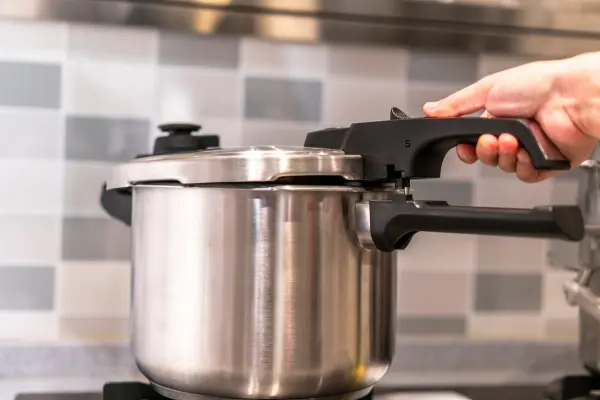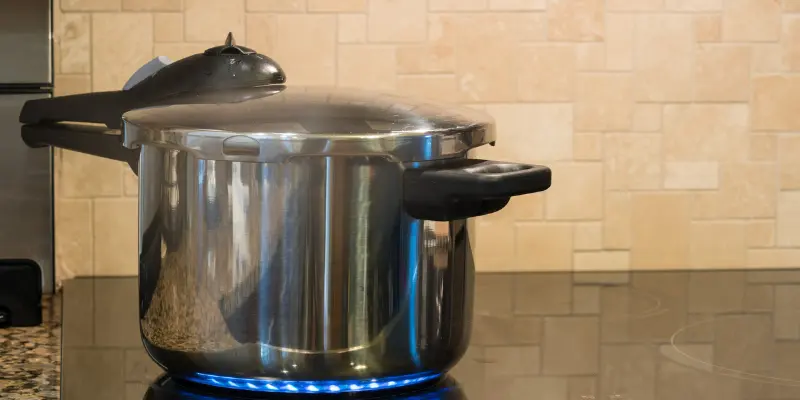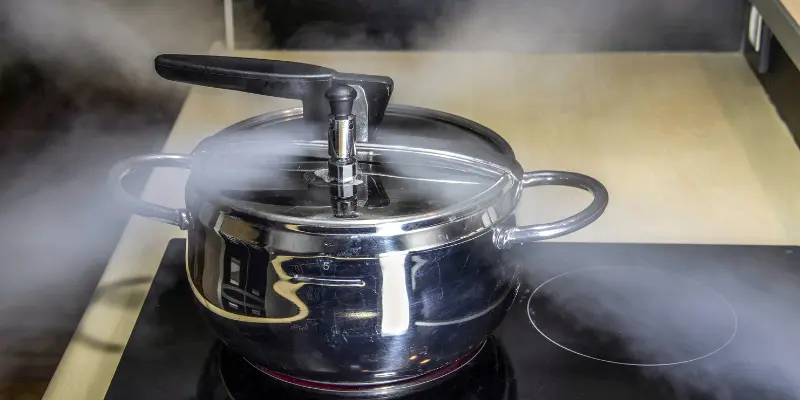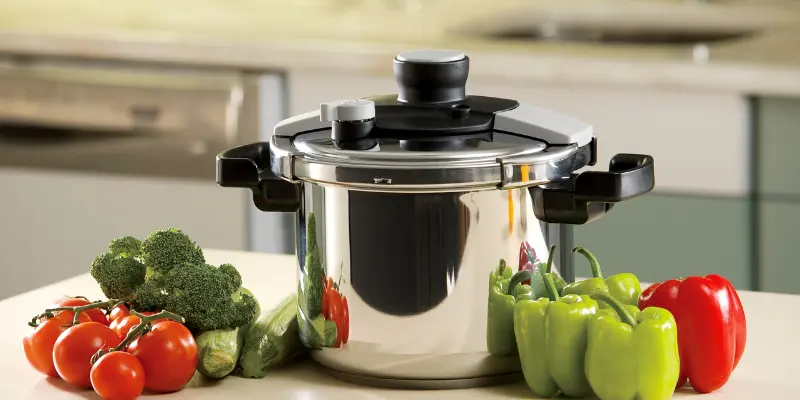Can You Use Pressure Cooker on Electric Stove?
Updated: 9 Jul 2025
226
Ever wondered if using a pressure cooker on your electric stove could be risky? You’re not alone. With so many homes using glass-top and coil-style stoves today, this question has become a hot topic in kitchens everywhere.
Many people fear pressure cookers might damage their stoves, cook unevenly, or cause pressure to build too fast. Others just don’t know which type of cooker is safe or how to use it correctly.
In this post, you’ll learn whether you can use a pressure cooker on an electric stove, how to do it safely, and what type of cooker works best. We’ve got you covered with expert insights, real experiences, and research-backed advice.
How Pressure Cookers Work & Why Heat Control Matters

Before we dive into stove compatibility, it’s important to understand how a pressure cooker works.
Here’s how it works:
- The water inside the cooker turns to steam.
- Steam builds pressure inside the sealed pot.
- That pressure raises the boiling point of water.
- Food cooks faster and retains more flavor.
Unlike gas stoves, electric burners take time to heat up and cool down. This delay can cause the pressure to rise too fast or not hold steady. That’s a problem when you’re using a stovetop pressure cooker on electric burner settings.
That’s why heat control is the #1 skill when using a pressure cooker for an electric coil stove or glass-top stove. You can’t just crank it up and walk away.
Can You Use a Pressure Cooker on an Electric Stove?
Yes, you can use a pressure cooker on an electric stove—but you need to follow some simple safety steps. Both coil burners and glass-top stoves can handle pressure cooking if you understand their behavior.
Using Pressure Cooker on Electric Stove Safely
- Start on medium heat to warm it up gradually.
- Watch the pressure indicator closely.
- As soon as pressure builds, lower the heat immediately.
- Never leave it unattended.
Electric burners don’t respond quickly. Even when you reduce the heat, the burner stays hot for a while. That’s why some people face issues like over-pressurization, food burning, or gasket failure.
Common Issues People Face
- Pressure builds too fast
- Food scorches at the bottom
- Pot shakes or whistles too loudly
Want to dig deeper into glass-top safety? Read this “Cook Smart: 9 Electric Stove Safety Guidelines for Secure Cooking”
Compatibility – Coil vs. Glass-Top Electric Stoves

One of the most common concerns people have is whether their specific type of electric stove is safe for pressure cooking. Let’s clear up the confusion.
Coil Electric Burners
Coil burners are the older, more traditional type of electric stove. Using a pressure cooker for electric coil stove is possible and safe—if done right.
Here’s what to keep in mind:
- Coil burners don’t distribute heat evenly. This means food can scorch at the bottom if you’re not careful.
- The burner takes time to cool down, which can lead to pressure overshooting.
- Use a heat diffuser to even out the temperature. It helps prevent hot spots.
Glass-Top (Smooth Surface) Stoves
Glass-top electric stoves look modern but have their own set of challenges. So, can you use pressure cooker on electric stove with a glass top?
Yes, but with extra caution.
Here’s why:
- Glass surfaces can scratch or crack under heavy weight or sudden movements.
- Many pressure cookers have rough or ridged bottoms—not ideal for smooth surfaces.
- The glass top retains a lot of residual heat, making it hard to control pressure precisely.
If you use a pressure cooker for glass top electric stove, follow these tips:
- Use flat-bottom stainless steel cookers.
- Lift—never drag the pot across the surface.
- Keep the bottom of the cooker and the stove clean to avoid burn marks.
- Don’t use oversized cookers that extend beyond the burner’s surface.
Also, check out our guide on Are Electric Stoves Suitable for All Cookware?
Using Pressure Cooker on Electric Stove Safely (Step-by-Step Guide)
Follow this step-by-step guide to get perfect results every time:

Step 1: Use the Right Pressure Cooker
- Choose a flat-bottom, heavy-duty pressure cooker.
- Prefer stainless steel over aluminum—it heats evenly and is durable.
- Make sure it’s compatible with glass top or coil burner stoves.
Step 2: Start With Medium Heat
- Don’t go straight to high heat.
- Medium heat helps pressure build gradually.
- This prevents sudden pressure spikes and food scorching.
Step 3: Monitor the Pressure Indicator
- As soon as the pressure indicator pops up, reduce the heat to low.
- On electric stoves, the coil or surface stays hot longer, so don’t delay.
Step 4: Use a Heat Diffuser (Optional)
- Helps regulate temperature, especially on coil electric stoves.
- Prevents hotspots and reduces the risk of burning.
Step 5: Don’t Leave the Stove Unattended
- Unlike modern electric pressure cookers, stovetop models need attention.
- Stay in the kitchen while pressure builds and releases.
Step 6: Let Pressure Release Naturally
- Unless the recipe says quick-release, allow the cooker to cool on its own.
- Moving the cooker off the burner helps lower the heat faster on electric stoves.
Step 7: Clean the Cooker After Every Use
- Check and clean the vent, gasket, and lid.
- Ensures long-term safety and proper functioning.
Best Pressure Cookers for Electric Stoves (Top Picks)
To avoid the issues we discussed, choose the best pressure cooker for electric stove based on your stove type.

| Pressure Cooker | Best For | Why It’s Great |
|---|---|---|
| Prestige Deluxe Stainless Steel | Glass-top stoves | Flat base, heavy-duty, modern safety features |
| Hawkins Contura | Coil burners | Curved body, thick base, even heating |
| Fissler Vitaquick | Both | German-engineered, silent operation, safe for all stovetops |
Common Problems & How to Avoid Them
Let’s go through the most common issues and how to fix them.
Problem 1: Pressure Builds Too Fast
- Cause: High heat setting or delayed heat reduction.
- Fix: Start with medium heat. As soon as pressure builds, lower the heat immediately.
- Get to know about Electric Stove Temperature 1–10 Guide: What Each Number Means
Problem 2: Food Burns at the Bottom
- Cause: Uneven heat or a thin-bottom pressure cooker.
- Fix: Use a heat diffuser and opt for heavy-bottomed stainless steel cookers.
Problem 3: Pressure Doesn’t Build Properly
- Cause: Gasket misalignment, weak burner output, or too much liquid.
- Fix: Ensure the sealing ring is clean, and use correct liquid amounts (usually 1–1.5 cups).
Problem 4: Loud Whistling or Shaking
- Cause: Pressure is too high or poor heat distribution.
- Fix: Monitor pressure settings. If the cooker starts shaking, reduce the heat fast.
Advanced User Tip – Use a Heat Diffuser for Better Results
If you’re still having trouble with uneven heating, burnt food, or sudden pressure spikes, try this:
Use a heat diffuser.
What’s a Heat Diffuser?
It’s a flat metal or ceramic disc that sits between the burner and the pot. It spreads the heat evenly across the bottom of your pressure cooker.
Why It Works
- Electric burners create hot spots—a diffuser evens them out.
- Reduces direct contact, especially useful for glass-top stoves.
- Helps prevent scorching, especially with thicker meals like stews or beans.
FAQs
How do I know if my pressure cooker is safe for glass tops?
Look for labels like “smooth-top compatible” or check manufacturer websites.
Should I use high heat to build pressure on a coil burner?
No. Start with medium heat, then reduce once pressure is reached.
Electric coils heat up slowly and cool slowly too—control is key.
What happens if I don’t reduce heat after pressure builds?
You risk overcooking, gasket damage, or food explosion. Always lower heat as soon as you see steam/whistle/indicator.
Can You Use Pressure Cookers for Canning on Electric Stoves?
Technically yes—but not always recommended on glass-top stoves because canning requires high, steady heat for long periods. That extended heat can damage glass cooktops.
Conclusion
So, can you use a pressure cooker on electric stove?
Yes, you can—safely and effectively, as long as you follow the right steps.
Use the correct type of pressure cooker with a flat, heavy base. Start with medium heat, and always lower it once pressure builds. Whether you’re using a glass-top or coil electric stove, it’s important to handle the pot gently.
In short, you can safely use a pressure cooker on an electric stove with just a little knowledge and attention. Now that you know how, it’s time to enjoy fast, tasty, and stress-free meals!
References
https://products.geappliances.com/appliance/gea-specs/PP9030DJBB/support
Please Write Your Comments